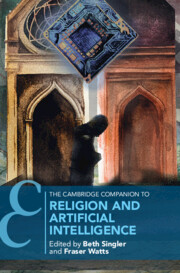Book contents
- The Cambridge Companion to Religion and Artificial Intelligence
- Cambridge Companions to Religion
- The Cambridge Companion to Religion and Artificial Intelligence
- Copyright page
- Contents
- Contributors
- Acknowledgements
- 1 Introduction
- 2 Steps towards Android Intelligence
- Part I Religions and AI
- 3 Hinduism and Artificial Intelligence
- 4 The Buddha in AI/Robotics
- 5 Artificial Intelligence and Jewish Thought
- 6 Artificial Intelligence and Christianity
- 7 Islam and Artificial Intelligence
- Part II Social and Moral Issues
- Part III Religious Studies
- Bibliography
- Index
- Cambridge Companions to Religion (continued from page ii)
- References
4 - The Buddha in AI/Robotics
from Part I - Religions and AI
Published online by Cambridge University Press: 20 November 2024
- The Cambridge Companion to Religion and Artificial Intelligence
- Cambridge Companions to Religion
- The Cambridge Companion to Religion and Artificial Intelligence
- Copyright page
- Contents
- Contributors
- Acknowledgements
- 1 Introduction
- 2 Steps towards Android Intelligence
- Part I Religions and AI
- 3 Hinduism and Artificial Intelligence
- 4 The Buddha in AI/Robotics
- 5 Artificial Intelligence and Jewish Thought
- 6 Artificial Intelligence and Christianity
- 7 Islam and Artificial Intelligence
- Part II Social and Moral Issues
- Part III Religious Studies
- Bibliography
- Index
- Cambridge Companions to Religion (continued from page ii)
- References
Summary
The global and historical entanglements between articifial intelligence (AI)/robotic technologies and Buddhism, as a lived religion and philosophical tradition, are significant. This chapter sets out three key sites of interaction between Buddhism and AI/robotics. First, Buddhism, as an ontological model of mind (and body) that describes the conditions for what constitutes artificial life. Second, Buddhism defines the boundaries of moral personhood and thus the nature of interactions between human and non-human actors. And finally, Buddhism can be used as an ethical framework to regulate and direct the development of AI/robotics technologies. It argues that Buddhism provides an approach to technology that is grounded in the interdependence of all things, and this gives rise to both compassion and an ethical commitment to alleviate suffering.
- Type
- Chapter
- Information
- Publisher: Cambridge University PressPrint publication year: 2024

